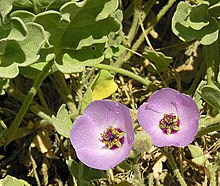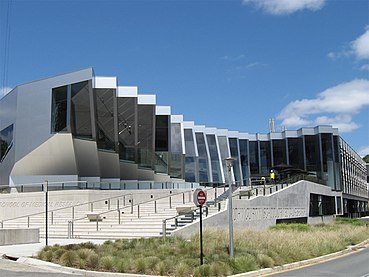SOX9
SOX9전사인자 SOX-9은 SOX9 [5][6]유전자에 의해 인간에게 암호화되는 단백질이다.
기능.
SOX-9은 HMG 박스급 DNA 결합 단백질의 다른 구성원과 함께 CCTTGAG 서열을 인식한다.그것은 전구세포를 연골세포로[7] 분화하는데 필수적인 비대증 연골세포를 증식시킴으로써 발현되며 스테로이드 생성인자 1과 함께 항뮬러 호르몬([6]AMH) 유전자의 전사를 조절한다.
SOX-9은 또한 남성의 성 발달에 중추적인 역할을 합니다; Sf1과 함께 일함으로써 SOX-9은 여성의 생식 [8]시스템의 생성을 억제하기 위해 Sertoli 세포에서 AMH를 생산할 수 있습니다.그것은 또한 남성 성기의 발달을 촉진하기 위해 몇몇 다른 유전자와 상호작용한다.전사인자 Testis 결정인자(Y염색체의 성결정영역 SRY에 의해 암호화됨)[9]가 유전자의 상류에 있는 인핸서 배열에 결합함으로써 SOX-9 활성을 활성화시킬 때 과정이 시작된다.다음으로 Sox9은 FGF9를 활성화하고 FGF9[10] 및 PGD2와 [9]피드포워드 루프를 형성합니다.이러한 루프는 SOX-9의 생산에 중요합니다.이러한 루프가 없으면 SOX-9은 고갈되고 암컷의 발육은 거의 틀림없이 뒤따를 것입니다.SOX-9에 의한 FGF9의 활성화는 고환 코드 생성 및 Sertoli 세포 [10]증식 등 남성 발달에서 중요한 과정을 시작한다.SOX-9과 Dax1의 결합은 실제로 남성 [11]발달의 또 다른 중요한 과정인 Sertoli 세포를 생성한다.뇌발달에서 그 쥐의 오르솔로그 Sox-9는 Wwp1, Wwp2, miR-140의 발현을 유도하여 신생 신경세포의 피질판 진입을 조절하고 [12]피질뉴런에서의 축삭 분기 및 축삭 형성을 조절한다.
임상적 의의
돌연변이는 종종 상염색체 성역전[6] 및 [13]구개열과 함께 골격 기형 증후군 캄포멜릭 이형증으로 이어진다.
SOX9은 인간의 17/24 유전자 사막에 있다.SOX9의 양쪽에 있는 문자 변환 유닛에서 1Mb보다 큰 위치에 있는 고도로 보존된 비코드 요소의 삭제, 중단 및 단일점 변환은 종종 [13][14]구개열과 관련되어 있습니다.
Sox9 단백질은 다발성 [15]고형종양의 시작과 진행에 모두 관여하고 있다.인간 발달 중 형태 형성의 주요 조절자 역할을 하기 때문에 악성 조직의 섭동에 이상적입니다.특히 Sox9은 전립선,[16] 대장,[17] 유방암[18] 및 기타 암에서 침윤성과 치료 저항성을 유도하는 것으로 나타나 치사 [19]전이를 촉진한다.Sox9의 이러한 종양 유발 효과의 대부분은 용량에 [20][16][15]의존한 것으로 보인다.
SOX9 현지화 및 다이내믹스
SOX9은 대부분 핵에 위치하여 이동성이 높습니다.연골세포주 연구는 SOX9의 거의 50%가 DNA에 결합되어 있으며 외부 요인에 의해 직접적으로 조절된다는 것을 밝혀냈다.DNA에 머무는 시간은 약 14초입니다.[21]
성전환의 역할
Sox9 또는 연관된 유전자의 돌연변이는 성전환과 양성애(또는 인간의 간성)를 일으킬 수 있다.Sox9에 의해 활성화된 Fgf9이 존재하지 않으면 X와 Y 염색체를 모두 가진 태아가 [9]여성 생식선을 발달시킬 수 있다. Dax1이 [11]존재하지 않는 경우에도 마찬가지다.암수동물의 관련 현상은 보통 X염색체에 옮겨져 일부 [22]세포에서만 활성화될 때 SRY의 비정상적인 활성에 의해 발생할 수 있습니다.
상호 작용
SOX9은 스테로이드 유발 인자 [8]1, MED12[23] 및 [24]MAF와 상호작용하는 것으로 나타났다.
「 」를 참조해 주세요.
추가 정보
- Ninomiya S, Narahara K, Tsuji K, Yokoyama Y, Ito S, Seino Y (March 1995). "Acampomelic campomelic syndrome and sex reversal associated with de novo t(12;17) translocation". American Journal of Medical Genetics. 56 (1): 31–4. doi:10.1002/ajmg.1320560109. PMID 7747782.
- Lefebvre V, de Crombrugghe B (March 1998). "Toward understanding SOX9 function in chondrocyte differentiation". Matrix Biology. 16 (9): 529–40. doi:10.1016/S0945-053X(98)90065-8. PMID 9569122.
- Harley VR (2002). The molecular action of testis-determining factors SRY and SOX9. Novartis Found. Symp. Novartis Foundation Symposia. Vol. 244. pp. 57–66, discussion 66–7, 79–85, 253–7. doi:10.1002/0470868732.ch6. ISBN 9780470843468. PMID 11990798.
- Kwok C, Weller PA, Guioli S, Foster JW, Mansour S, Zuffardi O, et al. (November 1995). "Mutations in SOX9, the gene responsible for Campomelic dysplasia and autosomal sex reversal". American Journal of Human Genetics. 57 (5): 1028–36. PMC 1801368. PMID 7485151.
- Foster JW, Dominguez-Steglich MA, Guioli S, Kwok C, Weller PA, Stevanović M, et al. (December 1994). "Campomelic dysplasia and autosomal sex reversal caused by mutations in an SRY-related gene". Nature. 372 (6506): 525–30. Bibcode:1994Natur.372..525F. doi:10.1038/372525a0. PMID 7990924. S2CID 1472426.
- Wagner T, Wirth J, Meyer J, Zabel B, Held M, Zimmer J, et al. (December 1994). "Autosomal sex reversal and campomelic dysplasia are caused by mutations in and around the SRY-related gene SOX9". Cell. 79 (6): 1111–20. doi:10.1016/0092-8674(94)90041-8. PMID 8001137. S2CID 24982682.
- Südbeck P, Schmitz ML, Baeuerle PA, Scherer G (June 1996). "Sex reversal by loss of the C-terminal transactivation domain of human SOX9". Nature Genetics. 13 (2): 230–2. doi:10.1038/ng0696-230. PMID 8640233. S2CID 22617889.
- Cameron FJ, Hageman RM, Cooke-Yarborough C, Kwok C, Goodwin LL, Sillence DO, Sinclair AH (October 1996). "A novel germ line mutation in SOX9 causes familial campomelic dysplasia and sex reversal". Human Molecular Genetics. 5 (10): 1625–30. doi:10.1093/hmg/5.10.1625. PMID 8894698.
- Meyer J, Südbeck P, Held M, Wagner T, Schmitz ML, Bricarelli FD, et al. (January 1997). "Mutational analysis of the SOX9 gene in campomelic dysplasia and autosomal sex reversal: lack of genotype/phenotype correlations". Human Molecular Genetics. 6 (1): 91–8. doi:10.1093/hmg/6.1.91. PMID 9002675.
- Cameron FJ, Sinclair AH (1997). "Mutations in SRY and SOX9: testis-determining genes". Human Mutation. 9 (5): 388–95. doi:10.1002/(SICI)1098-1004(1997)9:5<388::AID-HUMU2>3.0.CO;2-0. PMID 9143916. S2CID 45387678.
- Wunderle VM, Critcher R, Hastie N, Goodfellow PN, Schedl A (September 1998). "Deletion of long-range regulatory elements upstream of SOX9 causes campomelic dysplasia". Proceedings of the National Academy of Sciences of the United States of America. 95 (18): 10649–54. Bibcode:1998PNAS...9510649W. doi:10.1073/pnas.95.18.10649. PMC 27949. PMID 9724758.
- De Santa Barbara P, Bonneaud N, Boizet B, Desclozeaux M, Moniot B, Sudbeck P, et al. (November 1998). "Direct interaction of SRY-related protein SOX9 and steroidogenic factor 1 regulates transcription of the human anti-Müllerian hormone gene". Molecular and Cellular Biology. 18 (11): 6653–65. doi:10.1128/mcb.18.11.6653. PMC 109250. PMID 9774680.
- McDowall S, Argentaro A, Ranganathan S, Weller P, Mertin S, Mansour S, et al. (August 1999). "Functional and structural studies of wild type SOX9 and mutations causing campomelic dysplasia". The Journal of Biological Chemistry. 274 (34): 24023–30. doi:10.1074/jbc.274.34.24023. PMID 10446171.
- Huang W, Zhou X, Lefebvre V, de Crombrugghe B (June 2000). "Phosphorylation of SOX9 by cyclic AMP-dependent protein kinase A enhances SOX9's ability to transactivate a Col2a1 chondrocyte-specific enhancer". Molecular and Cellular Biology. 20 (11): 4149–58. doi:10.1128/MCB.20.11.4149-4158.2000. PMC 85784. PMID 10805756.
- Thong MK, Scherer G, Kozlowski K, Haan E, Morris L (August 2000). "Acampomelic campomelic dysplasia with SOX9 mutation". American Journal of Medical Genetics. 93 (5): 421–5. doi:10.1002/1096-8628(20000828)93:5<421::AID-AJMG14>3.0.CO;2-5. PMID 10951468.
- Ninomiya S, Yokoyama Y, Teraoka M, Mori R, Inoue C, Yamashita S, et al. (September 2000). "A novel mutation (296 del G) of the SOX90 gene in a patient with campomelic syndrome and sex reversal". Clinical Genetics. 58 (3): 224–7. doi:10.1034/j.1399-0004.2000.580310.x. PMID 11076045. S2CID 28618271.
- Preiss S, Argentaro A, Clayton A, John A, Jans DA, Ogata T, et al. (July 2001). "Compound effects of point mutations causing campomelic dysplasia/autosomal sex reversal upon SOX9 structure, nuclear transport, DNA binding, and transcriptional activation". The Journal of Biological Chemistry. 276 (30): 27864–72. doi:10.1074/jbc.M101278200. PMID 11323423.
레퍼런스
- ^ a b c GRCh38: 앙상블 릴리즈 89: ENSG00000125398 - 앙상블, 2017년 5월
- ^ a b c GRCm38: 앙상블 릴리즈 89: ENSMUSG000000567 - 앙상블, 2017년 5월
- ^ "Human PubMed Reference:". National Center for Biotechnology Information, U.S. National Library of Medicine.
- ^ "Mouse PubMed Reference:". National Center for Biotechnology Information, U.S. National Library of Medicine.
- ^ Tommerup N, Schempp W, Meinecke P, Pedersen S, Bolund L, Brandt C, et al. (June 1993). "Assignment of an autosomal sex reversal locus (SRA1) and campomelic dysplasia (CMPD1) to 17q24.3-q25.1". Nature Genetics. 4 (2): 170–4. doi:10.1038/ng0693-170. PMID 8348155. S2CID 12263655.
- ^ a b c "Entrez Gene: SOX9 SRY (sex determining region Y)-box 9 (campomelic dysplasia, autosomal sex-reversal)".
- ^ Kumar, Vinay; Abbas, Abul K.; Aster, Jon C. (2015). Robbins and Cotran pathologic basis of disease (Ninth ed.). p. 1182. ISBN 9780808924500.
- ^ a b De Santa Barbara P, Bonneaud N, Boizet B, Desclozeaux M, Moniot B, Sudbeck P, et al. (November 1998). "Direct interaction of SRY-related protein SOX9 and steroidogenic factor 1 regulates transcription of the human anti-Müllerian hormone gene". Molecular and Cellular Biology. 18 (11): 6653–65. doi:10.1128/mcb.18.11.6653. PMC 109250. PMID 9774680.
- ^ a b c Moniot B, Declosmenil F, Barrionuevo F, Scherer G, Aritake K, Malki S, et al. (June 2009). "The PGD2 pathway, independently of FGF9, amplifies SOX9 activity in Sertoli cells during male sexual differentiation". Development. 136 (11): 1813–21. doi:10.1242/dev.032631. PMC 4075598. PMID 19429785.
- ^ a b Kim Y, Kobayashi A, Sekido R, DiNapoli L, Brennan J, Chaboissier MC, et al. (June 2006). "Fgf9 and Wnt4 act as antagonistic signals to regulate mammalian sex determination". PLOS Biology. 4 (6): e187. doi:10.1371/journal.pbio.0040187. PMC 1463023. PMID 16700629.
- ^ a b Bouma GJ, Albrecht KH, Washburn LL, Recknagel AK, Churchill GA, Eicher EM (July 2005). "Gonadal sex reversal in mutant Dax1 XY mice: a failure to upregulate Sox9 in pre-Sertoli cells". Development. 132 (13): 3045–54. doi:10.1242/dev.01890. PMID 15944188.
- ^ Ambrozkiewicz MC, Schwark M, Kishimoto-Suga M, Borisova E, Hori K, Salazar-Lázaro A, et al. (December 2018). "Polarity Acquisition in Cortical Neurons Is Driven by Synergistic Action of Sox9-Regulated Wwp1 and Wwp2 E3 Ubiquitin Ligases and Intronic miR-140". Neuron. 100 (5): 1097–1115.e15. doi:10.1016/j.neuron.2018.10.008. PMID 30392800.
- ^ a b Dixon MJ, Marazita ML, Beaty TH, Murray JC (March 2011). "Cleft lip and palate: understanding genetic and environmental influences". Nature Reviews. Genetics. 12 (3): 167–78. doi:10.1038/nrg2933. PMC 3086810. PMID 21331089.
- ^ Benko S, Fantes JA, Amiel J, Kleinjan DJ, Thomas S, Ramsay J, et al. (March 2009). "Highly conserved non-coding elements on either side of SOX9 associated with Pierre Robin sequence". Nature Genetics. 41 (3): 359–64. doi:10.1038/ng.329. PMID 19234473. S2CID 29933548.
- ^ a b Jo, A; Denduluri, S; Zhang, B; Wang, Z; Yin, L; Yan, Z; Kang, R; Shi, LL; Mok, J; Lee, MJ; Haydon, RC (December 2014). "The versatile functions of Sox9 in development, stem cells, and human diseases". Genes & Diseases. 1 (2): 149–161. doi:10.1016/j.gendis.2014.09.004. PMC 4326072. PMID 25685828.
- ^ a b Nouri, M; Massah, S; Caradec, J; Lubik, AA; Li, N; Truong, S; Lee, AR; Fazli, L; Ramnarine, VR; Lovnicki, JM; Moore, J; Wang, M; Foo, J; Gleave, ME; Hollier, BG; Nelson, C; Collins, C; Dong, X; Buttyan, R (9 January 2020). "Transient Sox9 Expression Facilitates Resistance to Androgen-Targeted Therapy in Prostate Cancer". Clinical Cancer Research. 26 (7): 1678–1689. doi:10.1158/1078-0432.CCR-19-0098. PMID 31919137.
- ^ Prévostel, C; Blache, P (November 2017). "The dose-dependent effect of SOX9 and its incidence in colorectal cancer". European Journal of Cancer. 86: 150–157. doi:10.1016/j.ejca.2017.08.037. PMID 28988015.
- ^ Grimm, D; Bauer, J; Wise, P; Krüger, M; Simonsen, U; Wehland, M; Infanger, M; Corydon, TJ (23 March 2019). "The role of SOX family members in solid tumours and metastasis". Seminars in Cancer Biology. 67 (Pt 1): 122–153. doi:10.1016/j.semcancer.2019.03.004. PMID 30914279.
- ^ Aguilar-Medina, M; Avendaño-Félix, M; Lizárraga-Verdugo, E; Bermúdez, M; Romero-Quintana, JG; Ramos-Payan, R; Ruíz-García, E; López-Camarillo, C (2019). "SOX9 Stem-Cell Factor: Clinical and Functional Relevance in Cancer". Journal of Oncology. 2019: 6754040. doi:10.1155/2019/6754040. PMC 6463569. PMID 31057614.
- ^ Yang, X; Liang, R; Liu, C; Liu, JA; Cheung, MPL; Liu, X; Man, OY; Guan, XY; Lung, HL; Cheung, M (14 January 2019). "SOX9 is a dose-dependent metastatic fate determinant in melanoma". Journal of Experimental & Clinical Cancer Research. 38 (1): 17. doi:10.1186/s13046-018-0998-6. PMC 6330758. PMID 30642390.
- ^ Govindaraj K, Hendriks J, Lidke DS, Karperien M, Post JN (January 2019). "Changes in Fluorescence Recovery After Photobleaching (FRAP) as an indicator of SOX9 transcription factor activity". Biochimica et Biophysica Acta (BBA) - Gene Regulatory Mechanisms. 1862 (1): 107–117. doi:10.1016/j.bbagrm.2018.11.001. PMID 30465885.
- ^ Margarit E, Coll MD, Oliva R, Gómez D, Soler A, Ballesta F (January 2000). "SRY gene transferred to the long arm of the X chromosome in a Y-positive XX true hermaphrodite". American Journal of Medical Genetics. 90 (1): 25–8. doi:10.1002/(SICI)1096-8628(20000103)90:1<25::AID-AJMG5>3.0.CO;2-5. PMID 10602113.
- ^ Zhou R, Bonneaud N, Yuan CX, de Santa Barbara P, Boizet B, Schomber T, et al. (July 2002). "SOX9 interacts with a component of the human thyroid hormone receptor-associated protein complex". Nucleic Acids Research. 30 (14): 3245–52. doi:10.1093/nar/gkf443. PMC 135763. PMID 12136106.
- ^ Huang W, Lu N, Eberspaecher H, De Crombrugghe B (December 2002). "A new long form of c-Maf cooperates with Sox9 to activate the type II collagen gene". The Journal of Biological Chemistry. 277 (52): 50668–75. doi:10.1074/jbc.M206544200. PMID 12381733.
외부 링크
- SOX9+단백질+인간(미국 국립의학도서관 의학 과목 표제(MeSH))
- UCSC Genome Browser의 SOX9 인간 유전자 위치.
- UCSC Genome Browser의 SOX9 인간 유전자 상세.
- PDB for UniProt: P48436(Human Transcription factor SOX-9)에서 PDBe-KB에서 사용할 수 있는 모든 구조 정보의 개요.
- PDB for UniProt: Q04887(마우스 문자 변환 계수 SOX-9)에서 PDBe-KB에서 사용할 수 있는 모든 구조 정보의 개요.









